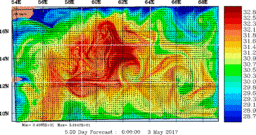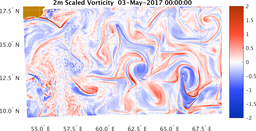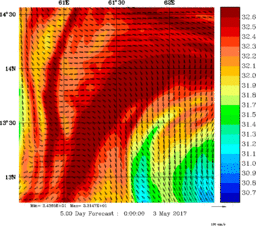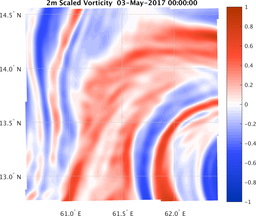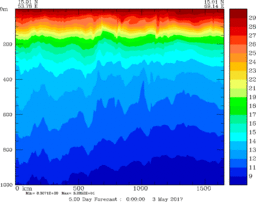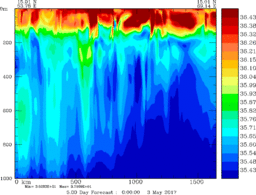Arabian Sea – February-April 2017
|
P.F.J. Lermusiaux, P.J. Haley, Jr., S. Jana, A. Gupta, C. Kulkarni, C. Mirabito, W. Ali, D. Subramani Massachusetts Institute of Technology Center for Ocean Engineering Mechanical Engineering Cambridge, Massachusetts
|
Real-time modeling Glider positions/data Data sources |
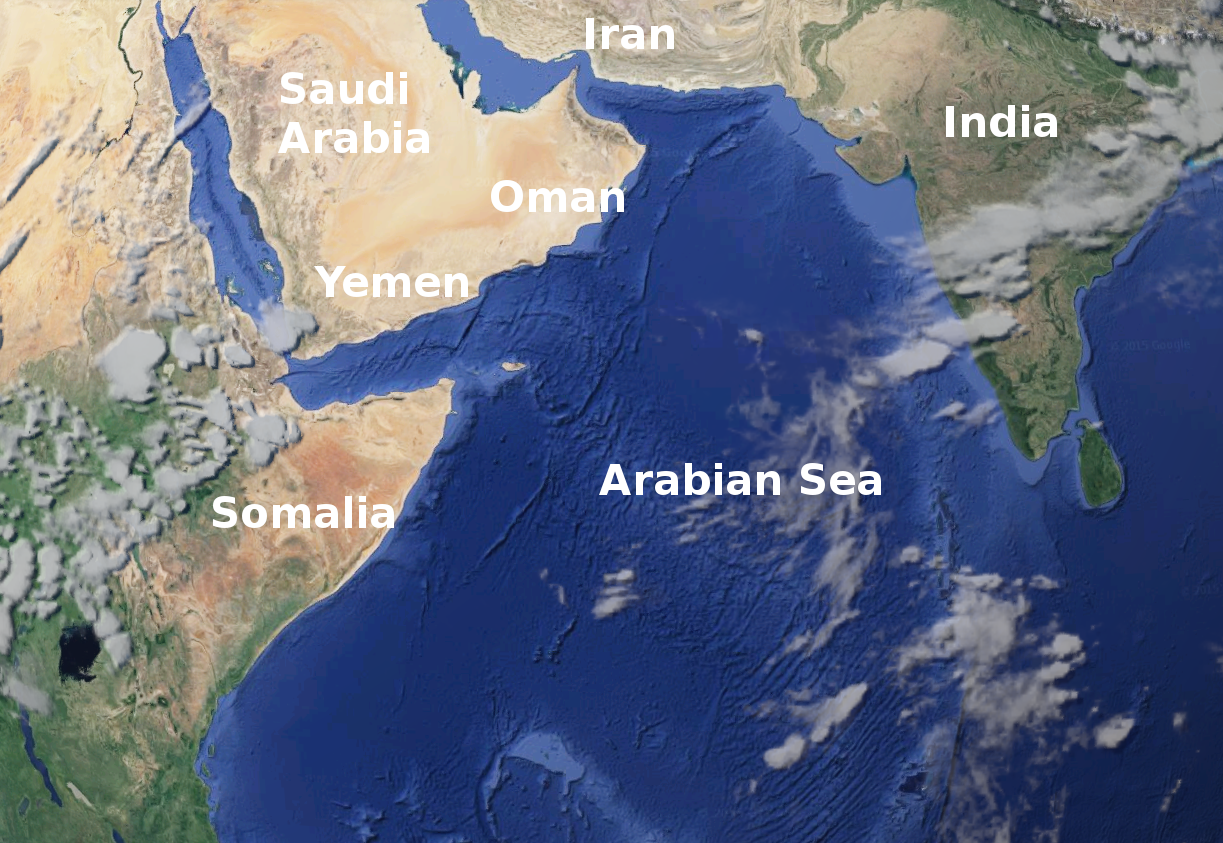 |
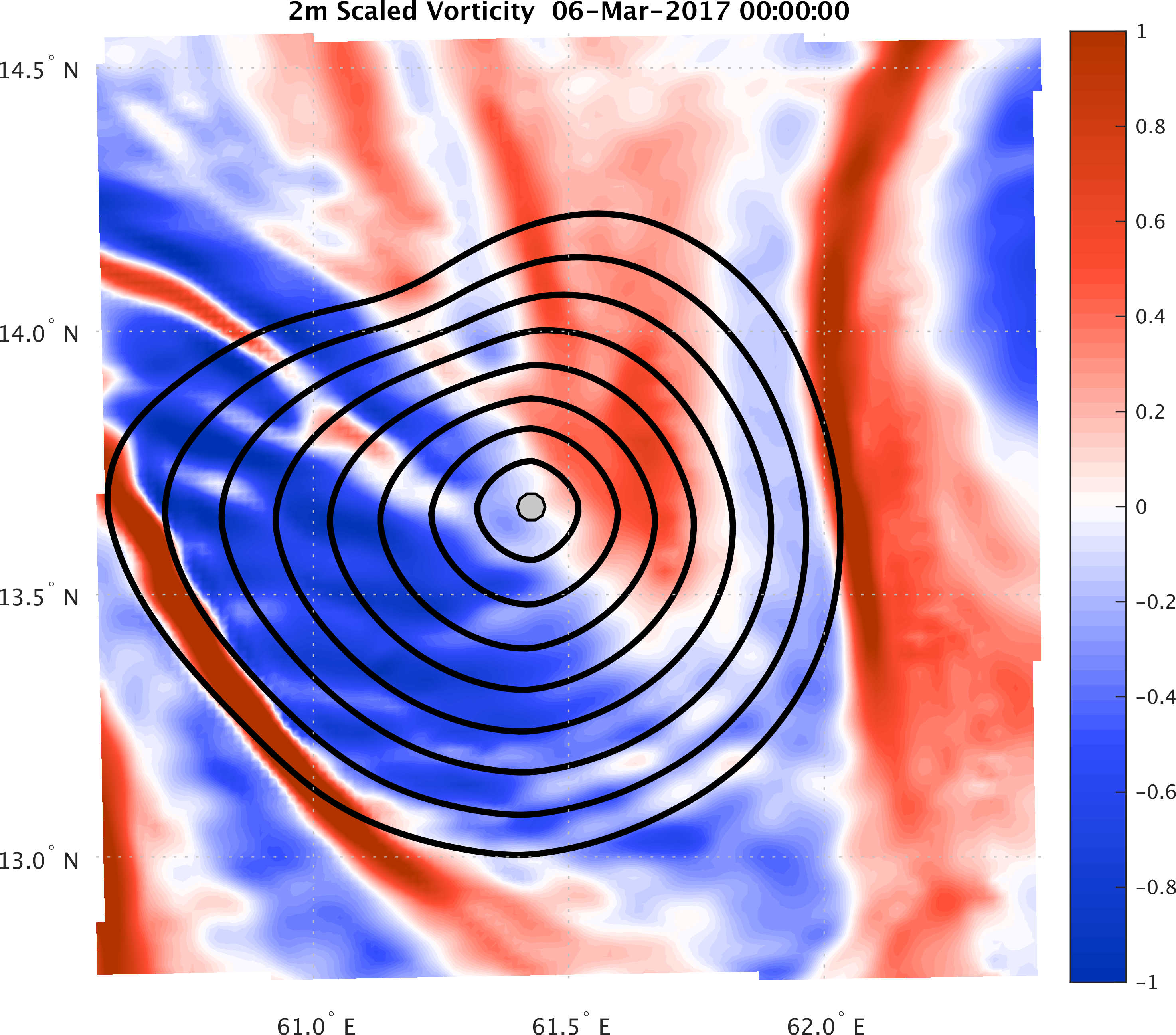 |
The NASCar-OPS Sea Exercise 2017 occurs in the Arabian Sea in February-April 2017. In collaboration with the DRI-NASCar team, our objectives are to utilize the MIT Multidisciplinary Simulation, Estimation, and Assimilation System (MSEAS) to: (i) forecast the regional high-resolution ocean fields and their probability, using our Error Subspace Statistical Estimation methodology; (ii) utilize these fields to forecast the reachability sets, reachability fronts, and time-optimal paths of underwater vehicles including gliders and floats; (iii) forecast the uncertainty of such reachability fields and optimal paths. We thank Dr. Andrey Shcherbina for his input, the HYCOM team for their real-time ocean fields, and the NCEP GFSp25 and NAVGEM 0p5 teams for their real-time atmospheric flux forecasts.
This research is sponsored by the Office of Naval Research.
Real-time MSEAS Ensemble Forecasting
- MSEAS ocean ensemble ESSE forecasts
Nowcast and Forecast Products
with dynamics and uncertainty descriptionsAnalyses and Forecasts Issued On April 1 2 5 9 13 17 21 25 29 Ocean
PhysicsHorizontal
MapsCentral Forecast X X X X X X X X X Operational
Vertical
SectionsCentral Forecast X X X X X X X X X Path Planning
and Reachability
FrontsGlider
Reachability
MapsCentral Forecast X X X X X X X X X Float Position Central Forecast X X X X X X X Nowcast and Forecast Products
with dynamics and uncertainty descriptionsAnalyses and Forecasts Issued On March April 1 2 3 4 5 6 7 8 9 10 11 12 13 14 15 16 17 18 19 20 21 22 23 24 25 26 27 28 29 30 31 1 2 Ocean
PhysicsHorizontal
MapsCentral Forecast X X X X X X X X X X X X X X X X X X X X X X X X X X X X X X X X X Mean and Uncertainty X X X X X X X X X X X X X X X X Operational
Vertical
SectionsCentral Forecast X X X X X X X X X X X X X X X X X X X X X X X X X X X X X X X X X Mean and Uncertainty X X X X X X X X X X X X X X X X Path Planning
and Reachability
FrontsGlider
Reachability
MapsCentral Forecast X X X X X X X X X X X X X X X X X X X X X X X X X X X X X Float Position Central Forecast X X X X X X X X X X X X X X X X X X Reachability Probablity X X X X X X X X X X Nowcast and Forecast Products
with dynamics and uncertainty descriptionsAnalyses and Forecasts Issued On February 9 10 11 12 14 15 16 17 18 19 20 21 22 23 24 25 26 27 28 Ocean Physics Horizontal Maps Central Forecast X X X X X X X X X X X X X X X X X X X Operational Vertical Sections Central Forecast X X X X X X X X X X X X X X X X X X X - MSEAS-processed atmospheric forcing flux forecasts:
NCEP GFSp25 NAVGEM 0p5 March 2017 S M T W T F S 1 2 3 4 5 6 7 8 9 10 11 12 13 14 15 16 17 18 19 20 21 22 23 24 25 26 27 28 29 30 31 February 2017 S M T W T F S 1 2 3 4 5 6 7 8 9 10 11 12 13 14 15 16 17 18 19 20 21 22 23 24 25 26 27 28 March 2017 S M T W T F S 1 2 3 4 5 6 7 8 9 10 11 12 13 14 15 16 17 18 19 20 21 22 23 24 25 26 27 28 29 30 31 February 2017 S M T W T F S 1 2 3 4 5 6 7 8 9 10 11 12 13 14 15 16 17 18 19 20 21 22 23 24 25 26 27 28 - WHOI ALAMO Float Summary
| Top of page |
Real-time Seaglider Positions and Data
Seaglider is a buoyancy driven autonomous underwater vehicle (AUV) developed by scientists and engineers at the University of Washington's School of Oceanography and Applied Physics Laboratory (APL).
- Real-time Seaglider Positions
- Seaglider Operations Summary
- Dive Results
- Additional links from ONR Arabian Sea (NASCar) Interior Working Group
| Top of page |
Data sources
- Ocean synoptic
- The Global Temperature and Salinity Profile Programme (GTSPP)
- National Data Buoy Center Real-Time & historical data from moored buoy & C-MAN stations
- Ocean historical/climatological
- The Global Temperature and Salinity Profile Programme (GTSPP)
- Data sets & products NOAA National Centers for Environmental Information
- World Ocean Database (WOD)
-
Northeast Fisheries Science Center Ecosystem Processes Division Oceanography Branch
NMFS. Includes data from CTDs, fish hauls, hull-mounted sensors, eMOLT
moorings, drifters, etc.
- Hydrographic Conditions of the Northeast Continental Shelf Northeast Fisheries Science Center Oceanography Branch
- Data/Mapping Interface Northeast Fisheries Science Center, Oceanography Branch
- Atmospheric forcing
- Weather Research and Forecasting (WRF) Model Real-Time Forecasts
- National Centers for Environmental Prediction (NCEP) products:
- Global Forecast System Model: version 4 (GFS), at 0.5 degree resolution (GFSp5) and also at 0.25 degree resolution (GFSp25)
- The European Centre for Medium-Range Weather Forecasts (ECMWF) ERA Intrim (global Re-Analysis)
- ESSO - Indian National Centre for Ocean Information Services (TropFlux project):
- Navy Global Environmental Model (NAVGEM) products:
| Top of page |


